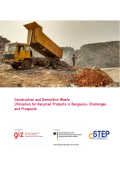
Biofuels have received global attention recently as governments across the world seek to address fuel efficiency, air quality and energy security. Biofuels are produced from renewable biological sources and are considered viable alternatives or supplements to fossil fuels. In order to support a broader shift towards biofuels, governments have introduced various policy measures; some of these include mandatory fuel blending programs, incentives for flex-fuel vehicles and agricultural subsidies for farmers. The Government of India in January 2003 launched its Ethanol Blended Petrol (EBP) Programme for 5% ethanol blended petrol. India’s EBP Programme sought to improve fuel efficiency and ensure protection from the price shocks of the global crude market. In 2009, the Government of India introduced a National Policy on Biofuels. The Policy focussed on further encouraging biofuel usage and reducing the prevailing dependence on fossil fuels, while it sought to mitigate environmental and fuel efficiency concerns. The Policy also recognised the significant opportunity that biofuels offer to India’s agricultural and industrial sectors.

Over the past decade, India’s cities have been witnessing an increasing trend in motorization with deteriorating air quality, and there have been calls to promote public transport as a way out of this gridlock. It is in this context that electric buses can play a positive role, as there are several benefits associated with the shift from conventional diesel buses to electric buses in terms of reduction in local pollution, noise, and fuel consumption. In spite of the many positive benefits related to the electric bus technology, certain challenges remain. Primary among these are costs and safety concerns. Currently, the Electric Vehicle (EV) technology is associated with significant capital costs, with the battery component constituting about half of the total manufacturing costs. Safety is yet another important parameter, and the biggest concern is that of a fire hazard. However, with a good Battery Management System (BMS), rigorous implementation of standard operating procedures, and customization of the bus fleet, both safety and cost aspects can be effectively addressed.

India is currently one of the fastest-growing economies in the world and the construction industry alone accounted for approximately 10% of its GDP in 2014. The Central Pollution Control Board (CPCB) classifies waste generated from the Construction and Demolition (C&D) of buildings and civil infrastructure as construction and demolition waste (CDW). The CPCB has estimated solid waste generation in India to be around 48 million tonnes per annum of which the construction industry accounts for approximately 25%. However, this estimate of 12-15 million tonnes of CDW is widely considered dated and a significant underestimate; but no updated comprehensive estimate for the country exists. In India, although some valuables are recovered from CDW and some of it is used for filling, most of it gets disposed in landfills or through unauthorised dumping in low-lying areas, open spaces, roadsides or water bodies creating enormous nuisance and environmental problems. India requires a paradigm shift from a dumping based approach to utilising CDW efficiently.

Until recently, the on-shore wind power potential in India was officially estimated to be 102 GW at a hub height of 80 m. About 26 GW of this potential has been installed in the country. However, there are multiple independent reassessment studies in the public domain that estimate the potential to be much higher. This is due to variations in assumptions and methodologies used. The main characteristic of these studies is that they take into account Land Use Land Cover (LULC) classifications and use a GIS-based methodology to estimate the wind power potential across the country. In order to achieve the national target of adding 60 GW of wind power capacity by 2022, it would be important to reassess the technical on-shore wind potential in the country and identify areas where the potential can be harnessed optimally. This would also be required to design and implement effective policies for capacity deployment. In this context, a Committee was constituted by the MNRE with an objective to reassess the technical on-shore wind potential of India for all major land types at a hub height of 100 and 120 m.

In June 2014 the Government of India launched the Power for All initiative with an aim to provide 24x7 power across the country by 2019. Subsequently, a sub-committee of the Forum of Regulators (FoR) prepared a national roadmap for the initiative. FoR defined the scope of the initiative to include reliable 24x7 power supply to domestic, industrial, and commercial consumers, power supply to irrigation pump sets for 8 to 10 hours, and access to all connected households by 2018–19. The roadmap made recommendations for fuel supply, generation, transmission and distribution sectors, and demand-side management. In view of the federal structure of India’s power sector, a key recommendation of the FoR study was to formulate state-level strategies to meet the objectives of 24x7 Power for All.
